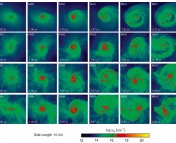• Title: Rapid AGN accretion from counter–rotating discs
• Authors: Christopher J. Nixon, Andrew R. King and Daniel J. Price
• First Author’s Institution: University of Leicester, Leicester, UK
The Background
One unsolved mystery of supermassive black holes (SMBHs) is how they grow to their great sizes. Are SMBHs a consequence of mergers? Do they form from the collapse of an extremely large star or dense stellar cluster? Or do they really just accrete mass until they become that large?
The accretion idea is tricky. When mass gets captured into an orbit around the SMBH, it has a lot of angular momentum to lose first before it can actually accrete onto the black hole. As an accreting object approaches a SMBH, tidal forces pull the object apart and spread it out to form an accretion disk around the black hole. It’s assumed that much of the object’s original angular momentum is then lost as a result of viscous interactions between particles within this disk. But it would take nearly the age of the Universe for a particle to accrete this way onto a standard-sized SMBH (~108 M☉), from the edge of a standard-sized disk (~1pc in radius).
Obviously this approach doesn’t work quickly enough to be able to grow the SMBHs that we observe — so does this mean we need to abandon the growth-by-accretion theory for SMBHs? According to the authors of this paper, we don’t … we just need to get creative when we think about how this accretion happens.
The Theory
The authors point out that there’s no reason to assume that all accretion events will be aligned, or that a single disk will form in a single plane. What if, instead, the accretion events are all random and misaligned — i.e., one object comes in from one direction, another object comes in from a different direction, and they form two disks with differing orientations around the same SMBH? The interactions between the two disks could potentially cause greater angular momentum loss (and faster accretion) than the traditional model of a single disk rotating in the same direction throughout.
To test this theory, the authors assume that two independent accretion events have occurred, resulting in an inner and an outer accretion disk with two different orientations. The disks’ angular momentum vectors are separated by an angle they denote as θ. With this setup, the authors conduct a numerical simulation of the disk using Phantom, a smoothed particle hydrodynamics (SPH) code, that can be used to model viscous interactions between particles in a disk.
The simulation starts with a flat disk of gas composed of 10 million SPH particles, with the inner half of the disk rotated by an angle θ relative to the outer half. The simulation is then allowed to run for many orbits, and the accretion rate and disk structure is tracked. This is repeated for values of θ between 0° (inner and outer disk are aligned and co-rotate) and 180° (inner and outer disk are aligned but counter-rotate), with the goal of determining how the accretion changes with the inclination angle.

Figure 1: Simulation results after ~10 orbits for various initial inclinations of the inner disk relative to the outer disk. From left to right, θ = 30°, 60°, 120° and 150°.
The Results
• θ < 90°: the two disks join via a low-density ‘warp region’ of gas that interacts between the disks, and this interaction gradually pulls the disks into closer alignment. Gas that enters the warp region falls through quickly due to the large angular momentum gradient, resulting in quicker accretion the larger the initial inclination angle is. See Figure 1, left two panels.
• θ > 90°: now there’s a component of the inner-disk angular momentum that directly cancels with the outer-disk angular momentum. This causes particles that interact between the two disks to fall inward rapidly, where they either accrete directly onto the black hole or fall to a closer orbit, forming an even smaller disk inside the inner disk. See Figure 1, right two panels.

Figure 2: Accretion rate for different inclination angles θ. Runs with θ > 90° are significantly more efficient at driving accretion than θ = 0°.
Conclusion
The authors conclude from their simulations that tilting one part of the disk relative to the other can result in accretion rates up to 104 times higher than the traditional single-plane disk (which would correspond to θ = 0°).
Figure 2 shows the accretion rates for various values of θ; while runs for 0° < θ < 90° accrete at fairly similar rates, runs for θ > 90° demonstrate an accretion spike early on as well as higher rates later. In the quasi-steady state, the rates for θ > 90° are typically around 100 times higher than those of a planar disk.
Exploring this possibility further could, indeed, reveal accretion as a viable means of growing a SMBH.




